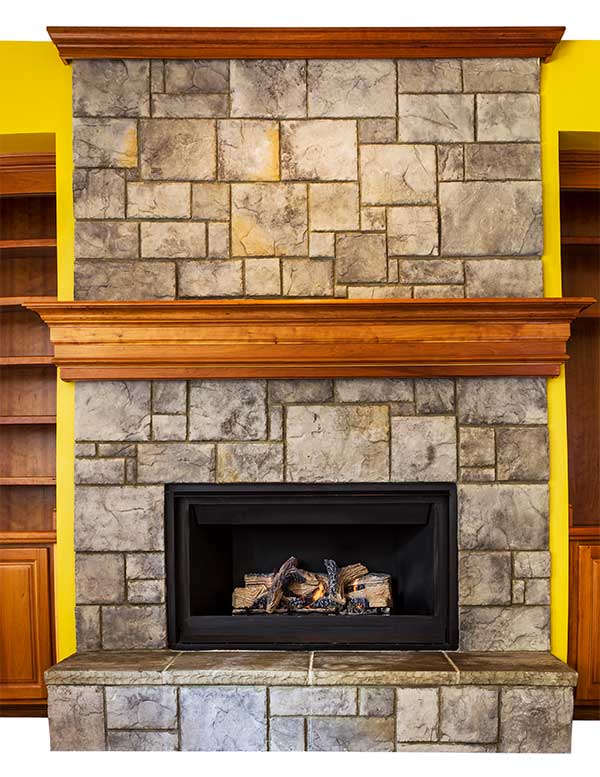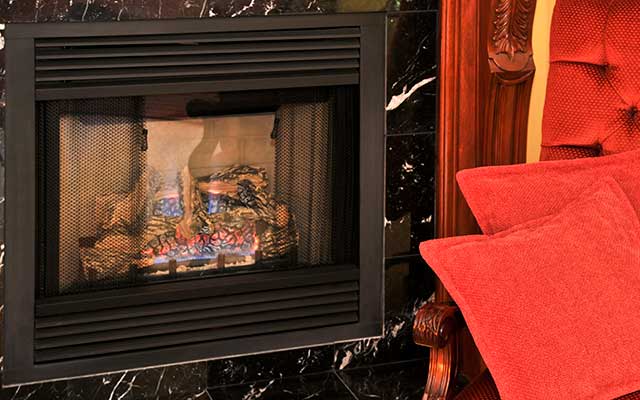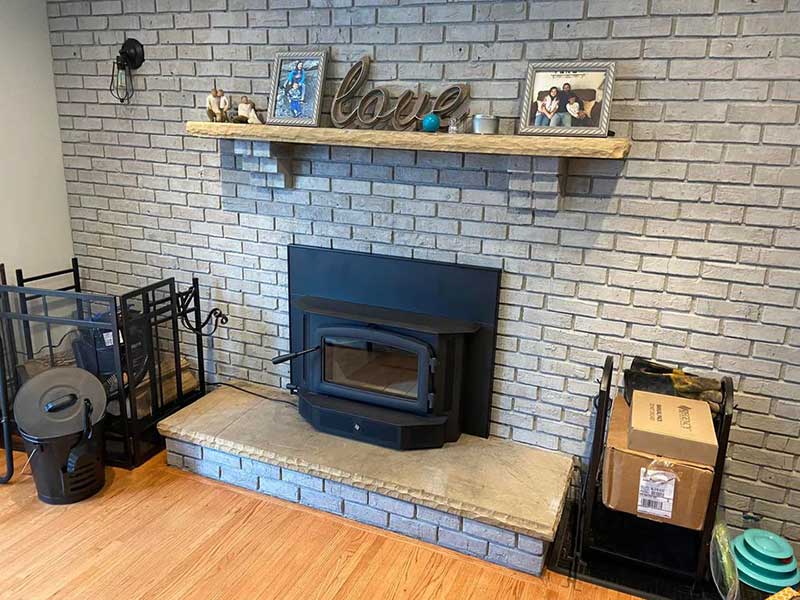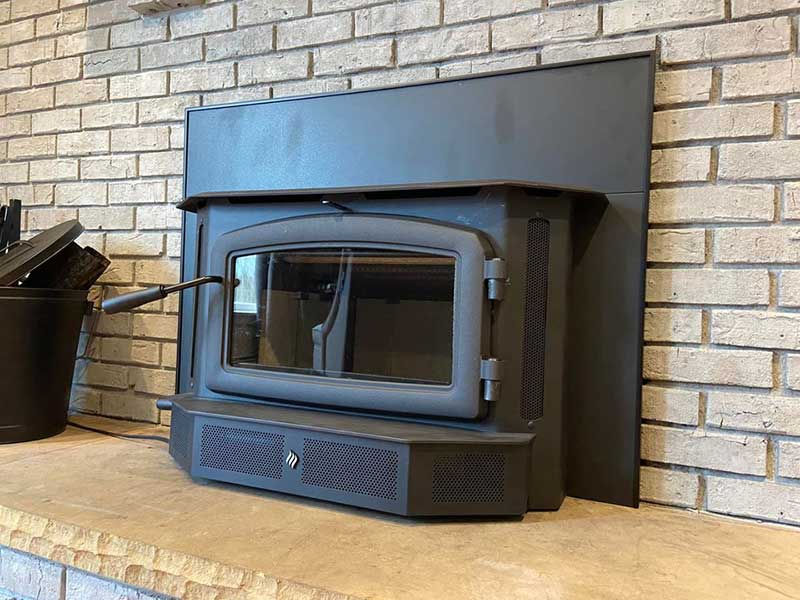Looking To Update Your Home Heating System? Ask Us About Insert & Fireplace Installation
When it comes to your home heating preferences, what’s most important to you? Ease of operation? Efficiency of heat production? Aesthetic and overall ambience? Regardless of what you’re looking for in a new heating system, Garden State Chimney is sure to have just the right product to fit your unique needs. We offer fireplace insert installation, new fireplace installs, and more!
At Garden State, honesty and integrity are at the heart of everything we do. Our end goal? To make the homes in our local community warmer, cozier, and safer. We believe in the certain kind of magic born in the glow of an ember, the flicker of flames, and those special moments with friends and loved ones around the hearth.
If you’re a homeowner in or around Passaic County, NJ on the hunt for a new fireplace or fireplace insert, you’ve come to the right place. Schedule with us online or by calling 973-519-0802. Let’s create the hearth of your dreams.
Is a Fireplace the Same as an Insert? How Do I Decide the Best One for Me?
Before we really get into it and dissect every little detail of our fireplace and insert offerings, it’s important to first define each. Due to the fact that so many people – both inside and outside the chimney/fireplace/home heating industry – often use “fireplace” and “insert” interchangeably, it can be understandably confusing when starting out on your shopping journey. Are they the same? Or are they two totally different appliances?
The truth is that they are, in fact, different appliances. They share a lot of similarities, especially in models that utilize the same fuel source, but to say they are the same product known by different names is untrue. What’s the difference, then? It mostly lies in the installation requirements and overall process.

- A fireplace insert, as alluded to in the name itself, is an appliance that has been specifically designed to the dimensions of an existing fireplace and chimney system and fits perfectly within. Installing a fireplace insert allows for the new appliance to utilize the features of the chimney that is already there (i.e. no need to drill new holes for exhaust ventilation – the flue is simply altered to accommodate for the change in system).
- A fireplace, on the other hand, has slightly less restrictions. Available as a traditional open-facing unit (with options concerning fuel source) or as a self-contained and covered model, fireplaces are more versatile when it comes to placement and precise location. Where an insert can only be installed into an existing hearth/chimney structure, the same is not true for many modern fireplaces. Depending on the specifics of the model you choose, a fireplace may either be vented – where they release the spent air outdoors courtesy of a flue system created through the wall or more traditionally, the ceiling/roof – or ventless where they get the air for combustion through a recycling-like process.
Now, as far as which one is the better choice…that’s really going to come down to you and what you’re looking for. They’re both really excellent options with a lot of potential for design, style, fuel customization, etc. It largely just depends on your end goal.
Questions? Concerns? General unspecified confusion? We’re here to walk you through it. Give us a call and we’ll help you choose the best appliance for your home.
What Are My Fireplace or Insert Options?
We’re glad you asked! While a classic and traditional fireplace – complete with flickering flames and crackling wood – may be ideal for some homeowners, it is not so appealing to others. That’s why the team here at Garden State is proud to offer a variety of alternatives, many with similar properties, to those looking for something a little different to fit their lifestyle.
When it comes to fireplace and insert options, we supply and install gas fireplaces, wood inserts, and gas inserts. Here is a brief overview, as well as some pros and cons, of each.
Gas Fireplace
Not to be confused with utilizing gas logs in a pre-existing chimney system, a gas fireplace is a self-contained unit. Depending on the specific type of appliance, a gas fireplace either vents exhaust through a flue system or recirculates air from the space in which it’s located.
Pros:
- Versatile. Because these appliances do not usually require a traditional chimney flue system, the installation options are practically endless. As long as you have an open wall with enough space to fit the unit of your choosing, you’re all set. Not to mention the fact that there are numerous detail and design options available, so you can be sure to get something that perfectly fits your vibe and the style of your home.
- Convenient. Gas fireplaces have become more and more popular in recent years because they offer a close alternative to the ambience created by wood-burning systems, while requiring less than half the work. Most gas fireplaces these days can even be operated via a remote – and some can even use Wi-Fi and connect to your smartphone or other devices – meaning that you can crank up the heat and create that cozy atmosphere without ever needing to leave the couch. Now that is pure, unbridled comfort.
- Zone heating. Modern gas fireplaces are much better at creating and maintaining a certain level of heat output – especially when compared to their predecessors. Because they’re designed to provide radiant heat, if you’re looking to heat a smaller space, a gas fireplace will certainly save you some money on your energy bills.
Cons:
- Less efficient. Yes, newer gas fireplaces are significantly more efficient than the models before them, but in the grand scheme of heating appliances, there are other options that could cost less to heat more. So, if you’re looking for something to heat your entire home, a gas fireplace might not be the best choice – unless you invest in some supplemental options as well.
- Higher upfront cost. There are always some trade-offs, right? While the cost of using an appliance such as a gas fireplace might even out over time, the installation price tag can be a bit expensive. Remember all the customization and design options we mentioned earlier? Those can add up and make your new gas fireplace quite an investment.
- Gas connection required. It’s important to note that, in order to install a gas fireplace in your home, your property must have the ability to connect to a natural gas or propane supply. If there is no way to hook up a gas line, other alternatives to wood will be tough to come by, thus significantly limiting your appliance and fuel options.
Gas Fireplace Insert
Ok, so here’s where it gets just a bit trickier. Gas fireplace inserts are commonly confused with gas fireplaces…and it’s easy to see why! Both are usually self-contained and fueled with either propane or natural gas, but remember – inserts get their name from the installation requirements and the fact they require an existing structure. Gas fireplace insert installation is fairly straightforward, making it a great option for those converting fuel types.
Pros:
- Safe. Gas inserts can feature a completely closed combustion system, meaning that all the fire happens behind a panel or some kind of glass covering. Because of this, they make a really great option for homeowners with young children or curious animals. Do still operate with caution, however – just because it’s contained doesn’t mean it won’t still burn if touched!
- More efficient. Historically – in a more traditional open-face fireplace setup, that is – a good deal of heat is lost up the chimney, which generally means you are spending more to receive less. Not the case with an insert! Because of their design, most of the heat produced is appropriately radiated right back into the living space.
- Easy to install. Provided your home already has a fireplace and chimney system in place, installing a gas insert is a relatively quick and easy process. (Note: when we say “easy,” we mean for a professional chimney sweep – not that it would be a cool opportunity to flex some DIY muscles).

Cons:
- Limiting. Yet again what might be a benefit in one circumstance, can just as easily be a hindrance in another. Even if you’re in pursuit of a highly efficient, visually-pleasing new heating appliance and think inserts are the answer, if your home does not already have an existing fireplace, unfortunately a gas fireplace insert isn’t an option for you.
- Less versatile. Similarly, unlike a gas fireplace which can largely be installed just about anywhere due to its difference in ventilation requirements, gas inserts are not as versatile or customizable as their fireplace counterparts. Not only are you limited by the mere presence of a chimney structure, you are also limited by size and dimension restraints. If you’re attempting a total redesign and want to upgrade or downgrade your whole hearth, a gas insert might not be a great choice.
- Decreased ambience. Sure, it’s still a “real” fire, but as with a gas fireplace, a gas insert will not provide the same ambience and cozy aesthetic inherently present in a wood-burning system. It may come close, for sure – but it just isn’t the same.
Wood Insert
If your home has a traditional fireplace that you love burning wood in, but are tired of the draftiness and heat loss from your home fires, a wood insert might be just the right option for you. There’s just something about the multi-sensory experience of heating with wood that is unmatched for so many, and wood inserts offer a more efficient closely related alternative.
Pros:
- Closest to traditional. As far as similar alternatives go, a wood insert is about as good as you can get. These handy units will solve many of the issues found with their fireplace predecessors such as heat loss, safety of use, and overall cleanliness.
- Efficient. Once again, because all the combustion air and heat production is maintained within the system itself (as opposed to getting lost up the chimney), a wood insert is significantly more efficient in warming up your space. Plus, if you have a glass covering, you won’t have to worry about excessive smoke blowing in and around your living space.
- Renewable resource. Perhaps one of the coolest parts about heating with wood (or uncoolest, depending on how you look at it – but we’ll get to that in a second), is the fact that you can collect, chop, and season your own fuel. Did you know that responsible forestry is actually incredibly beneficial to the ecosystem?

Cons:
- Resource accessibility. Wood may be a renewable resource, but that doesn’t always mean it’s easily accessible to every homeowner. Depending on what area of Northern New Jersey you live in, it might be more hassle than it’s worth to try and get your hands on some wood to burn.
- More maintenance. Wood-burning appliances are, in a way, quite primal. They require intention to spark and attention to maintain. Plus, no matter the unit or model (or whether it is a more traditional fireplace), there will always be some semblance of a mess in one place or another from storing wood and clearing ash.
- More pollutant smoke. Gas may be a fossil fuel, but it burns much cleaner than wood. The particulate matter found in wood smoke can actually be quite harmful not only to the environment, but also to the people in your home. This is especially true if any family members have existing respiratory problems.

Feeling dizzy? Even more confused than when you first found yourself on this page? Just looking to schedule your annual inspection or chimney cleaning and somehow found yourself here? Don’t worry – we’re here to help you make the best choice for your home and your family, as well as take care of any chimney repair or other maintenance needs.
Call on the talented chimney technicians of Garden State Chimney at 973-519-0802, or you can reach out online to schedule a time to chat about options. We’ll be sure to get you squared away with your new fireplace or insert appliance in no time.
Is There a Cost Difference Between Inserts and Fireplaces?
You may have noticed that when it comes to product and service costs, we don’t really like to plaster them all over our website. Why? Well, because, while there are some offerings that generally fall under the same price umbrella, this is not always the case. As a leader in our field and a premier service provider for homeowners in our local Passaic County area, we value honesty and transparency above all else and never wish to provide false information to customers or those soon to be.
All that said, depending on the specific model or unit of the appliance, the product and installation costs are somewhat similar for inserts and fireplaces. For more information about our pricing – or if you’re looking for an estimate for an insert or fireplace installation service – get in touch with a member of our team. We’d be more than happy to go over all of that with you once we have a better idea what you’re in the market for.
Can I Install a Fireplace or Insert Myself? Why Should I Trust a Professional?
Listen, we love a good home project as much as anyone else, but do we think you should take it upon yourself to install a new heating appliance like an insert or a fireplace?
No. No, we do not. YouTube might make it look simple enough and there are enough “DIY fireplace installation” articles to make anyone believe that they can do it with ease, but we know the truth. And the truth is that a fireplace – any kind of fireplace – is an intrinsically complicated system, not only in terms of its functionality and overall operation, but also (perhaps especially) when it comes to the installation.
Regardless of fuel type or specific unit/model/appliance, it is always better, safer, and ultimately more cost effective in the long run to work with a professional than to make an attempt yourself.
Though it shouldn’t come as a surprise that fire-housing systems are naturally dangerous structures, it often does. Wouldn’t you rather trust the experts who deal with this stuff all the time? Plus, because all of our chimney sweep technicians are highly trained and experienced, you can rest assured our installation services will go much quicker and more smoothly, maximizing the time that you and your family get to spend warming up in front of your new fireplace or insert.
Can You Convert My Wood-Burning System to One Fueled by Gas?
You bet. Thanks to modern technology and fireplace and chimney system advancement, it is easier than ever to switch up your fuel source.
Looking to maintain the open-hearth look? Let’s look at our gas log options and what materials most appeal to you.
Tired of the draft, the smell, and the smoke from burning wood? Perhaps a gas insert is the best option.
We can come out and grab the specific measurements and dimensions we need to make sure you get set up with just the right gas insert. You’re sure to love the improved heat production and lack of smelly smoke, among all the other features associated with a gas-fueled heating system.
Ready To Schedule Your Upgrade?
Ready to schedule your fireplace or insert installation? Looking to take care of some fireplace or chimney repair services? Need answers for something else chimney-related? If you’re a homeowner in Northern New Jersey and any of these queries apply to you, you’re in the right place.
Give us a call at 973-519-0802 or book your next appointment right here on the website. We can’t wait to serve you. For all fireplace and chimney services, don’t hesitate… Call Garden State!
Check with us if you need gas fireplace service. The trained techs at Garden State Chimney are ready to help.
